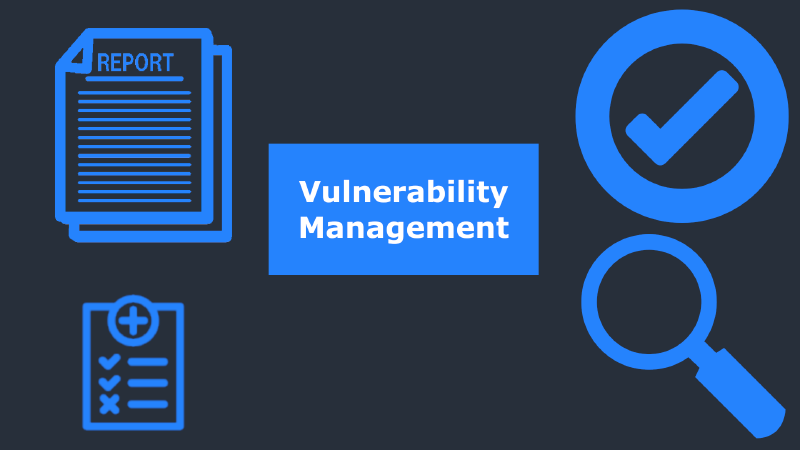5 minutes
Vulnerability Management Process

What is Vulnerability Management?
Vulnerability management is a process that involves identifying, assessing, and mitigating vulnerabilities in an organization’s systems and applications. The goal of vulnerability management is to proactively identify vulnerabilities before they can be exploited by attackers and to implement controls and mitigation strategies to reduce the risk of a successful attack.
The vulnerability management process typically involves the following steps:
- Vulnerability Scanning
- Vulnerability Assessment
- Risk Prioritization
- Remediation
- Verification
- Continuous monitoring
What is the need to establish Vulnerability Management process?
Organizations need a vulnerability management process to identify and mitigate security vulnerabilities in their systems and applications. Here are some reasons why vulnerability management is essential:
1. Proactive security: A vulnerability management process allows organizations to take a proactive approach to security. By identifying and mitigating vulnerabilities before they can be exploited by attackers, organizations can reduce their risk exposure and prevent potential security breaches.
2. Compliance requirements: Many industries and regulations require organizations to have a vulnerability management process in place. Compliance requirements may include regular vulnerability scans, risk assessments, and remediation activities.
3. Reputation and trust: Security breaches can damage an organization’s reputation and erode customer trust. By implementing a vulnerability management process, organizations can demonstrate their commitment to security and protect their reputation.
4. Cost savings: A vulnerability management process can help organizations identify and mitigate vulnerabilities before they can lead to a security breach. By preventing security breaches, organizations can avoid the costs associated with remediation, legal fees, and reputational damage.
5. Competitive advantage: Organizations that have a strong security posture, including an effective vulnerability management process, can differentiate themselves from competitors and gain a competitive advantage.
How to establish the Vulnerability Management process?
As a security engineer or lead, the following steps can be taken to establish a vulnerability management process in the organization:
1. Assess the current state of the organization’s security: Before implementing any vulnerability management process, it’s important to assess the organization’s current security posture. This can be done by conducting a security assessment or audit to identify vulnerabilities and weaknesses in the organization’s systems and processes.
2. Develop a vulnerability management plan: Based on the results of the security assessment, develop a vulnerability management plan that outlines the procedures and steps that will be taken to identify, assess, and mitigate vulnerabilities.
3. Define roles and responsibilities: Establish clear roles and responsibilities for vulnerability management within the organization. Define who will be responsible for scanning, identifying, tracking, and mitigating vulnerabilities.
4. Conduct regular vulnerability scans: Conduct regular vulnerability scans on all systems and applications to identify any new vulnerabilities. Scans should be conducted on a regular basis, and after any significant changes to the network or systems.
5. Prioritize vulnerabilities: Prioritize vulnerabilities based on their severity and the impact they could have on the organization. This will help to focus on the most critical vulnerabilities first.
6. Develop a remediation plan: Develop a remediation plan to address identified vulnerabilities. The plan should include details on how vulnerabilities will be mitigated, who is responsible for the remediation, and the timeline for remediation.
7. Monitor remediation progress: Monitor the progress of remediation efforts to ensure that vulnerabilities are being addressed in a timely manner. Establish regular reporting and follow-up processes to ensure that vulnerabilities are being addressed.
8. Implement a continuous improvement process: Vulnerability management is an ongoing process that requires continuous improvement. Regularly review the vulnerability management plan, assess the effectiveness of the process, and make any necessary changes or improvements.
9. Train employees: Train employees on the importance of vulnerability management and how to report vulnerabilities. Encourage a culture of security within the organization, where employees are aware of their role in protecting the organization from cyber threats.
Pre-requisite to start with Vulnerability Management process
Before starting with vulnerability management, there are several prerequisites that need to be in place. Here are some key prerequisites:
1. Asset Inventory: It’s important to have an up-to-date inventory of all the hardware, software, and network devices in the organization. Without an accurate inventory, it will be difficult to identify vulnerabilities and prioritize remediation efforts.
2. Security Policy: The organization should have a security policy in place that outlines the standards, guidelines, and procedures for managing vulnerabilities. This policy should be communicated to all employees and stakeholders.
3. Vulnerability Scanning Tools: A vulnerability scanning tool is essential for identifying vulnerabilities in the organization’s systems and applications. The tool should be capable of scanning all network devices, servers, and applications and should be configured to run on a regular basis.
4. Incident Response Plan: The organization should have an incident response plan in place to handle security incidents and vulnerabilities. The plan should include procedures for identifying, containing, mitigating, and reporting vulnerabilities.
5. Training: Employees should be trained on how to report vulnerabilities, the importance of vulnerability management, and how to follow the organization’s security policies and procedures.
6. Resources: Adequate resources, including personnel and budget, should be allocated for vulnerability management. This includes hiring or training staff to manage the vulnerability management process and investing in tools and technologies to support the process.
List of tools for Vulnerability Management
There are many tools available for vulnerability management, including both commercial and open-source options. Here are some of the most popular tools:
- Nessus
- Qualys
- OpenVAS
- DefectDojo
- Archery
By following these steps, a security engineer or lead can establish a robust vulnerability management process in the organization that can help identify and mitigate vulnerabilities before they can be exploited by attackers.
Suggestions and improvements are always welcome. :)
Vulnerability Management Continuous monitoring Compliance requirements Vulnerability Assessment SAST DAST IAST Secret Scanning SCA
922 Words
2023-04-21 12:07